NOx refers to a class of pollutants that is any binary compound of nitrogen and oxygen and is a main contributor to what is commonly referred to as smog. It is most commonly produced in combustion processes, but can also be generated in non-combustion processes like metal refining, picking baths, or nitric acid manufacturing to name a few. The following link: EPA NOX technical bulletin, provides a good overview of NOx as a pollutant, but focuses mostly on NOx formed by combustion processes.
referred to as smog. It is most commonly produced in combustion processes, but can also be generated in non-combustion processes like metal refining, picking baths, or nitric acid manufacturing to name a few. The following link: EPA NOX technical bulletin, provides a good overview of NOx as a pollutant, but focuses mostly on NOx formed by combustion processes.
This blog post focuses on non-combustion NOx abatement using packed bed scrubbers. In general a NOx Scrubber System can be comprised of a single packed bed absorber to several other system components, including:
-
Quencher
-
Stage 1 Packed Bed: Conversion of NO to NO2
-
Stage 2 Packed Bed: Absorption and Reduction of NO2
-
Stage 3 Packed Bed: H2S Odor Control.
The actual configuration will depend on a combination of factors including:
The temperature of the inlet gas
- The ratio of NO/NO2
- The Outlet NO limit
- Preferences of the plant regarding the risk of H2S odors.
Each component is further described below.
Quencher - The quench stage is used to cool the gas to the saturation in the case the inlet gas is hot. This is done with an evaporative quencher constructed of metal.
Stage 1 Packed Bed: Conversion of NO to NO2 - This stage is used in the case there is a sufficiently high concentration of NO in the inlet gas stream or sufficiently low outlet concentration limit for NO. NO is essentially insoluble in water, but it can be quickly oxidized to NO2 by chlorine dioxide (ClO2) or ozone (O3). This can be done using a packed bed, but the reaction of NO actually occurs in the gas phase. The packed bed functions as a ClO2 generator and static mixer, or as a static mixer for ozone injected in the form of an aqueous solution. ClO2 can be generated by the reaction of sodium chlorite (NaClO2) with a strong acid. Sulfuric acid (H2SO4) is commonly used, but if the air being scrubbed contains enough nitric acid fumes, it may not be necessary to add much H2SO4. Most NOx scrubbers don't have an oxidation stage. When NOx is generated by the reaction of nitric acid with metals, it usually consists mainly of NO2. NO is invisible, and it is much less toxic than NO2. (The Threshold Limit Value for 8-hour workplace exposure to NO is typically 25 ppmv, vs. 3 ppmv for NO2.)
Stage 2 Packed Bed: Absorption and Reduction of NO2 - NO2 reacts only slowly with caustic solutions, and when it does, a competing reaction with water converts part of the NO2 back to NO. So scrubbing NO2 using NaOH alone is very inefficient. For efficient removal of NO2, a strong reducing agent that reacts faster (usually sodium hydrosulfide: NaHS) is added as required to maintain an ORP of about -400 mV in the scrubbing solution. NaOH is added as required to maintain pH ≥ 12.5, in order to minimize H2S emissions.
Stage 3 Packed Bed: H2S Odor Control - This stage is optional. If the pH and ORP settings in Stage 2 are adjusted properly, there will be little H2S released from that stage. However, the strongly alkaline hydrosulfide solution in Stage 2 is a severe environment for pH and ORP probes, so the probes will tend to get out of calibration faster than they would in a scrubber operating at lower pH levels. Some customers with NOx scrubbers prefer to install a caustic scrubbing stage as a second line of defense against odor emissions. This may be more important to plants located near other businesses or a residential community. The wastewater from Stage 3, containing excess NaHS and excess NaOH, can be recycled to the sump of Stage 2 in order to reduce chemical usage there.
Please click the icons below to view a video of a packed bed scrubber and a horizontal quencher video.

Photo Credit: monovinyl



 The adjacent photo shows a 400 lb/hr medical waste incinerator scrubber with a Venturi inlet flow rate of 1,200 scfm. The reflux damper can be seen as the white horizontal duct from the ID fan outlet to the Venturi inlet on the right hand side of the rectangular condenser/absorber box.
The adjacent photo shows a 400 lb/hr medical waste incinerator scrubber with a Venturi inlet flow rate of 1,200 scfm. The reflux damper can be seen as the white horizontal duct from the ID fan outlet to the Venturi inlet on the right hand side of the rectangular condenser/absorber box.
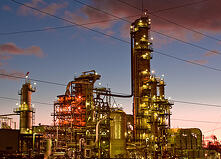
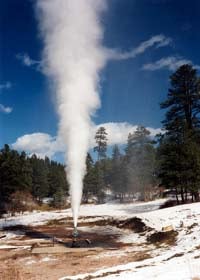 Removal of the bulk particulate load - Removal of the bulk particulate load may be required if there is a high particulate concentration from the upstream process. This will be the case for secondary lead smelters, lead refining, and refinery sludge incinerators. Geothermal energy plants will not have this requirement. A bag-house will be used for secondary lead smelters and lead refining. A wet Venturi scrubber system can be used for refinery sludge incinerators Removal of the bulk particulate minimizes space-charge effects inside the WESP. Space-charge effects occur when particles interact and repel each other. This reduces WESP performance because it interferes with the migration of charged particle to the tube wall for collection.
Removal of the bulk particulate load - Removal of the bulk particulate load may be required if there is a high particulate concentration from the upstream process. This will be the case for secondary lead smelters, lead refining, and refinery sludge incinerators. Geothermal energy plants will not have this requirement. A bag-house will be used for secondary lead smelters and lead refining. A wet Venturi scrubber system can be used for refinery sludge incinerators Removal of the bulk particulate minimizes space-charge effects inside the WESP. Space-charge effects occur when particles interact and repel each other. This reduces WESP performance because it interferes with the migration of charged particle to the tube wall for collection.

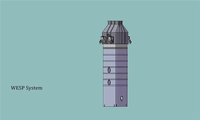

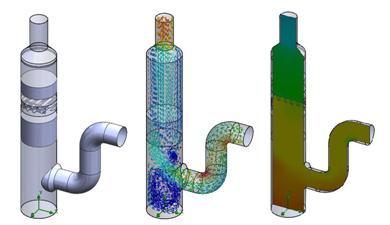


 As the EPA continues to tighten the emissions belt, I am seeing new industries with air emissions issues. One such industry is pharmaceuticals, who are now more commonly regulated for acid gases on post-combustion devices.
As the EPA continues to tighten the emissions belt, I am seeing new industries with air emissions issues. One such industry is pharmaceuticals, who are now more commonly regulated for acid gases on post-combustion devices.
 owing pollutants.
owing pollutants. control to meet the more stringent standards. Envitech has had success achieving higher removal efficiencies by integrating an add-on particulate polishing package (PPP) into incinerator wet scrubber systems. The PPP is comprised of a skid mounted package that provides slight reheat of the gas temperature to slightly above saturation in combination with a filter system. The reheat eliminates the potential for condensation build-up in the filters.
control to meet the more stringent standards. Envitech has had success achieving higher removal efficiencies by integrating an add-on particulate polishing package (PPP) into incinerator wet scrubber systems. The PPP is comprised of a skid mounted package that provides slight reheat of the gas temperature to slightly above saturation in combination with a filter system. The reheat eliminates the potential for condensation build-up in the filters.
 Venturi scrubber
Venturi scrubber
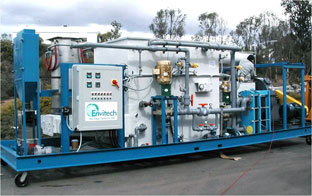

 Acid gases can be found in the exhaust of a large number of combustion processes. As a gas, the acid compounds usually are not particularly corrosive and are relatively easy to remove. However, when the temperature of the gas drops below the acid gas dewpoint, an acid mist can form. The acid mist can turn into a fine aerosol or it can condense on a cold surface. Acid mist poses a number of design problems, due to the small size of the mist particles and the corrosivity of the liquid form of the acid.
Acid gases can be found in the exhaust of a large number of combustion processes. As a gas, the acid compounds usually are not particularly corrosive and are relatively easy to remove. However, when the temperature of the gas drops below the acid gas dewpoint, an acid mist can form. The acid mist can turn into a fine aerosol or it can condense on a cold surface. Acid mist poses a number of design problems, due to the small size of the mist particles and the corrosivity of the liquid form of the acid.
